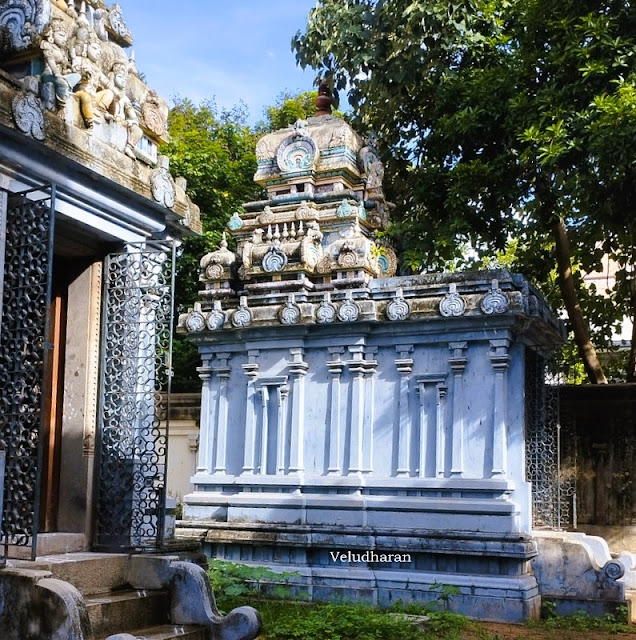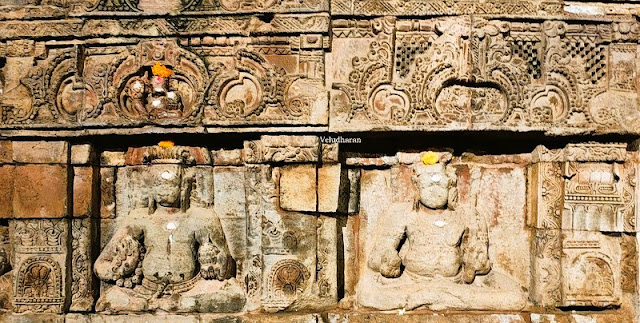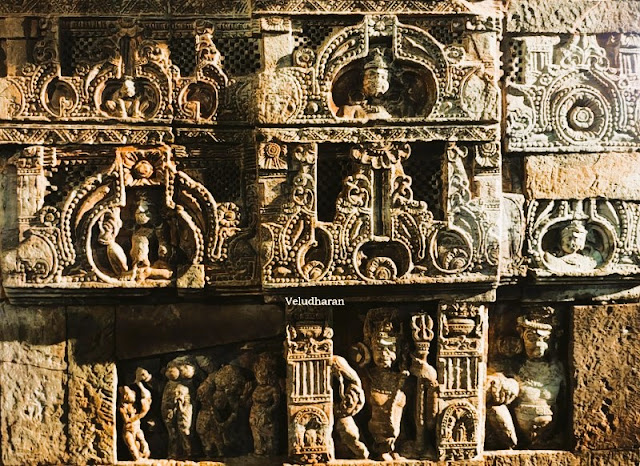Kanadukathan
is an important place for the Chettiars, and usually, Kanadukathan is called a
Chettinad. The Palace of Rajah Sir Annamalai Chettiar is in Kanadukathan. He was the founder of Annamalai University. I had the opportunity to visit the
Palace. Many Tamil films utilized this Palace for shooting. Some of the
photographs taken are uploaded in this post.
Saturday, 30 November 2024
Chettinad Rajah Sir Annamalai Chettiar Aranmanai / Palace, Kanadukathan/Chettinad, Sivaganga District, Tamil Nadu
Sri Lakshmi Kamakshi Temple/ஸ்ரீ லக்ஷ்மி காமாட்சி கோயில், RA Puram, Bishop Garden St, Krishnapuri, Raja Annamalai Puram, Chennai, Tamil Nadu.
A
unique Lakshmi Kamakshi Temple and the Deity image is a replica of Kanchipuram
Kamakshi Amman at RA Puram, Chennai. The temple has a connection with Kanchi
mutt Maha Periyavaa and Ramana Maharishi. Visited the temple on the Vijayadasami day, 12th October
2024.
PC-Website
Moolavar : Sri Lakshmi Kamakshi
Some
of the salient features of this temple are….
The
temple faces east with a 5-tier Rajagopuram. A two-tier Rajagopuram with Tulasi
madam is on the backside. Balipeedam, Dwajasthambam and Simha vahanam are
after the Rajagopuram. Ambal Lakshmi Kamakshi is in a sitting posture, similar to the Kanchipuram Kamakshi Amman Temple. Ambal’s
various forms are in the koshtam.
In Praharam Vinayagar (Gifted by Ramana Maharishi), Utsava Murthy, Ashtabhuja Amman,
Thulasi Madam, Ayyanar with Poorna and Pushkala, Adi Sankara, Goshala, Shiva
and Parvati bas relief, and Nagaras are under the peepal tree.
The
Yaga sala, and Utsavars are in the mukha mandapam built in front of the temple.
Ayyanar with his consorts
ARCHITECTURE
The
whole temple was constructed with brick and cement concrete. The temple
consists of sanctum sanctorum and ardha mandapam. A separate mandapam is in
front of the temple with a gap of about 8 feet. The Sanctum Sanctorum and
Mandapas are on an upanam and Pada bandha adhistanam, with jagathy, three patta
kumudam, and pattikai. A 3-tier Salakara Vimanam is above the Sanctum Sanctorum.
The Parapet wall of the Sanctum Sanctorum was constructed like a hara with a number
of small sannidhis. These hara sannidhis are stucco images of Ambal’s
various forms. Some of the mandapam pillars are constructed like Pallava-period
squatting Lion pillars with Kalasam, kudam, palakai, and Tharanga pothyal.
HISTORY
AND INSCRIPTIONS
This
Lakshmi Kamakshi temple was constructed as a replica of the Kanchipuram Kamakshi
Amman Temple about 40 years before. This temple was built by Sri Chavali
Subramania Sastri, from Andhra Pradesh, an ardent devotee of Kanchi
Paramachariya. When Chavali Subramania Sastri asked Maha Periyava to use 10 ground land at RA Puram, a part of Chennai. Knowing everything Maha Periyavaa was asked to construct a replica temple of Kanchi Kamakshi Amman Temple
and maintain it as a private temple. It was said that Maha Periyavaa himself did pooja to the new Kamakshi Murti for a mandala and transferred all his powers.
Maha Periyava also handed over a Kataka mala for Kamakshi Amman. In addition,
Maha Periyava advised Chavali Subramania Sastri to install the Vinayagar, which
he received from Ramana Maharishi in the temple itself. Sri C S Sastri passed
away in 1988, and after that, the temple was looked after by his family members
residing near this temple.
As Mr. Narendra, one of C S Sastri’s close
relatives, commented on a post in Mahaperiyavaa. blog, mentions it as….. Members of
my family (Late Sri Chavali Sastry Garu and Late Sri Maganti Suryanarayana
Garu) have been ardent devotees of the Kamakoti Matham and have been close
aides of the Paramcharya. Sons of the Late Sri Chavali Sastry Garu, Sri. Chavali
Sriram Garu (my uncle) and his brothers built the Sri Lakshmi Kamakshi temple at RA
Puram under the direction of the Paramacharya in that regard.
Sri
Chavali Subramanya Sastri sent rupees ten lakh for the golden gopura of the
Temple (Kamakshi temple of Kanchipuram..?) in the name of the Pamacharya. This
shows Chavali Sastri’s devotion towards Kanchi Maha Periyavaa.
HH
Maha Periyava Jayendra Saraswathi Swamigal and Vijayendra Saraswathi Swamigal camped
for a month at the Sri Lakshmi Kamakshi Temple on Greenways Road. A
Chandramouliswarar pooja with an ancient lingam bought specifically by the
acharyas from Kanchipuram for this purpose was on till 2 p.m. during their
Visit. Special poojas were held throughout the day on that occasion (Mylapore
Times Friday, March 20, 2015)
Ref
and
Paper news
POOJAS AND CELEBRATIONS
Daily
poojas and rituals are carried out similarly to Kanchipuram Kamakshi Amman
Temple. The Naivedyams are prepared as directed by Maha Periyava.
Gents are required to remove their Shirts and Banyans before entering the ardha mandapam. Since this is a private temple, the time when Devotees are allowed in the ardha mandapam next to the Sanctum Sanctorum is unpredictable. Otherwise, devotees have to worship Kamakshi, either from the separate mandapam in front of
the temple or standing before the steps.
Apart
from regular poojas, Navaratri is celebrated in a grand manner with Homams.
Navaratri Utsavam
TEMPLE
TIMINGS
The
temple will be kept open between 06.30 hrs and 10.30 hrs and between 17.00 hrs and 20.30
hrs.
CONTACT
DETAILS
For
details, please contact the mobile and landline numbers +919444925000, +91 9444071186, and +91 44 24937521.
HOW
TO REACH
From
Adyar towards Santhome or Mylapore, turn left on the Greenways Road (Andhra
Mahila Sabha Hospital) and turn 2nd right on the Greenways Road
called Greenways Road Extension, and the temple is at the last of the street.
The nearest railway Station is Greenways Road MRTS Station, and Jn. is the Central Station.
LOCATION
OF THE TEMPLE: CLICK HERE
Thulasi madam & west Side Rajagopuram
Adi Sankara Sannidhi
Vinayagar Sannidhi- Vinayagar was gifted by sri Ramana Maharishi

---
OM SHIVAYA NAMA ---
Labels:
Amman Temples,
Ayyanar,
Chennai District
Friday, 29 November 2024
Shree Parsurameswara Temple / ପର୍ଶୁରାମେଶ୍ୱର ମନ୍ଦିର, Kedar Gouri Vihar, Old Town, Bhubaneswar, Odisha.
The visit to this Shree Parasurameswara Temple at Bhubaneswar, Odisha was a part of the “Kalinga and Ottara Desa Heritage Walk” organized by சோழ மண்டல வரலாற்றுத் தேடல் குழு, between 13th to 18th September 2024. The purpose of this Heritage walk was to see the places, monuments, etc., which are directly or indirectly connected as proof of Rajendra Chozha-I’s victory mentioned in his Meikeerthi/title over Kalinga and Ottara Desa, the present Andhra Pradesh and Odisha.
A Sahasra Linga is in front of the Temple
PC-website
Moolavar: Shree Parasurameswara
Some of the salient features of this temple are….
The temple faces west and is dedicated to Shiva situated within a low enclosure wall. Moolavar, a Shiva Linga is in the sanctum sanctorum. A Sahasra Linga and a Shiva Lingam with snake kavasam are in the praharam.
ARCHITECTURE
Parsurameswara is one of the earliest intact temples in Bhubaneswar. This is a small but lavishly decorated and exquisitely finished temple and a typical representative example of the early Orissan Temples. Parsurameswara was originally known as Parasavara, named after a Lakulisa teacher. Apart from Images of Lakulisa, there are also depictions of Nataraja, Durga, Saptamatrika, Surya, musicians, and Ashta Dikpala deities. The episodes of Shiva occur in three different places in the main temple. The first in the front face, just above the jagamohan shows the scene of Ravana lifting Mount Kailash. The second episode is that of Annapurna offering alms to Shiva and the third is of Shiva's marriage scene.
The Temple consists of a Deula and Jagamohana. The Deula about 12.8 m has no platform. The Triratha temple has Trianga Bada with a squattish and thickest Gandi, While the Jagamohana instead of being a stepped pyramid tower is a rectangular peristyle, Structure Whose roof is in the form of a sloping terrace, above which is a clerestory over which there is another sloping roof with a flat top. The deula has niches for the Parivara devatas on three sides. The reliefs are narrative in character forming a repertoire of Shaiva myths. The carvings are chaste, elegant, and well-known for their sturdy volume. The exteriors of both Jagamohana and duela are profusely decorated and remarkable for cult images, especially, notable for their charming poses, suppleness of outlines, and restrained ornamentation.
HISTORY
Since there is no inscriptional evidence found in this temple to prove its antiquity, the temple is assignable to circa 7th Century. The Inscription on the southern door of jagamohan indicates that the earlier name of this temple was Parasaresvar.
Ref:
1. Archaeological Survey of India Website.
2. Display board installed at the entrance of the Temple.
LOCATION OF THE TEMPLE: CLICK HERE
--- OM SHIVAYA NAMA---
Labels:
Odisha,
Other States,
Shiva Temples
Subscribe to:
Comments (Atom)


























































